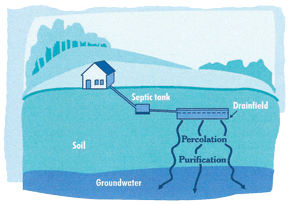Septic and Waste Treatment
Today’s septic system technology is very good. However, these systems must be properly installed and maintained to be effective. Property owners are individually responsible for the proper installation and maintenance of their private septic systems. Septic systems are designed to collect household waste in a tank and then filter pollutants and wastewater through leach fields. Septic systems break down and neutralize contaminants before they enter ground or surface water systems. Properly designed, installed and maintained septic systems play an important part in maintaining water quality in the Flathead Watershed. Septic systems include four components: a pipe from the house, a tank which holds and begins to treat solid wastes, a distribution system which moves liquid wastes, and a drain or leach field.
 |
 |
| Figure 5.5: Residential septic system. Source: U.S. EPA | Figure 5.6: Residential septic field. Source: U.S. EPA |
The septic tank is a buried, watertight container typically made of concrete (but sometimes made of fiberglass, or polyethylene). It holds wastewater, allowing solids to settle, and oil & grease to rise to the surface. The wastewater exits the septic tank and is discharged into the drain field for further treatment by the soil. Soil is a critical part of a septic system. Naturally occurring microbes and chemical processes in soil break down and remove bacteria, viruses, and nutrients. Because soil moisture and texture influences the effectiveness of septic systems, soil type is taken into account when designing systems.
Installation
Septic systems must be designed to meet state and county regulations, and be approved by local authorities. In general, they are located at least 100 feet (30.5 m) from any surface water, well, spring, or 100-year floodplain.
Maintenance
Septic systems need to be inspected at least every three years, and pumped every three to five years depending on use. Inspectors look for the fullness of the tank and also check for leaks. Although many tanks last indefinitely, some develop cracks potentially contaminating groundwater and posing serious human health threats. If possible, homeowners should organize neighborhood or community pumping as pumpers will often reduce the price for large jobs. Pumped sludge and scum have to be disposed of, either by putting it to beneficial use via application on farmland or by disposal at a wastewater treatment plant.
Water Use & Disposal
There are a number of steps that can be taken to ensure that a septic system lasts and does not contaminate waterways:
- Use non-phosphate soaps and detergents. Phosphate-containing soaps and detergents are banned in both Flathead and Lake Counties. Reducing phosphorous protects the waterways and prolongs the life of your septic system.
- Be sure to have your tank pumped even if you use products that claim to protect your septic system. Some of the products can clog your leach field and contaminate groundwater. All reputable additive manufacturers indicate that routine maintenance, such as pumping, still needs to be done even when using their products.
- Never flush expired or unwanted pharmaceuticals down the toilet or drain. They can leach into groundwater and contaminate drinking water. Flathead and Lake Counties have a personal care product disposal program to safely dispose of pharmaceuticals. Recent studies in Montana and throughout the U.S. have found prescription and over-the-counter pharmaceuticals in rivers, groundwater, and municipal drinking water supplies. Wastewater treatment facilities and septic systems are not designed to treat or eliminate these contaminants.
- Never flush household chemicals, gasoline, oil, pesticides, antifreeze, or paint products as they can stress or destroy the natural biological treatment in the system or contaminate groundwater.
Use cleaning products with care. Many common household products can cause damage to your septic system when used in excess. - Use garbage disposals sparingly as they increase the amount of solids and grease entering the septic system. Consider whether you think it really makes sense to use groundwater to get rid of waste
- Use water efficiently. The less water a household uses, the less pressure it puts on the septic system.
- Consider using a high efficiency toilet or reducing the water in your toilet tank.
- High-efficiency showerheads and faucet flow restrictors also reduce water use. Repair leaking faucets.
- Turn off faucets when shaving or brushing your teeth.
- Run the dishwasher and clothes washer only when they are full.
Community sewer facilities add an enormous density of waste to the water system. Wastewater treatment plants in the Flathead Watershed have been upgraded over the years to meet or surpass state mandated phosphorus limits and have reduced “point source” pollution considerably. Point sources are identifiable outlets such as municipal and public sewage, stormwater outfall, and industrial discharges. New public systems in Lakeside and Somers and the expansion of areas served by public systems such as Evergreen, Whitefish Mountain, Whitefish Lake, and Bigfork have contributed to protecting our water quality. The amount of nutrients reaching Flathead Lake has been reduced through these upgrades efforts and the banning phosphorous-containing household cleaners. All citizens and businesses have a critical role, a stake, and a responsibility in maintaining healthy water systems and in reducing water pollution.
| Resources | |
| Citizens for a Better Flathead 406.756.8993 http://flatheadcitizens.org |
Lake County Environmental Health Department 406.883.7236 http://www.lakecountymt.us/environmentalhealth |
| Confederated Salish & Kootenai Tribes 406.675.2700 http://www.cskt.org |
Montana Department of Environmental Quality http://deq.mt.gov/default.mcpx 406.444.4969 Designs for septic systems, circular WQB |
| Flathead Basin Commission 406.240.3453 http://www.flatheadbasincommission.org Healthy Lakes Through Living Shores DVD |
National Resources Conservation Service http://www.mt.nrcs.usda.gov 406.587.6856 |
| Flathead Conservation District 406.752.4220 http://www.flatheadcd.org |
Web Soil Survey http://soils.usda.gov/survey |
| Flathead County Environmental Health Department 406.758.5760 http://www.flatheadhealth.org/envhealth |
Septic Yellow Pages http://www.septicyellowpages.com Listings for professional septic pumpers, installers, inspectors, and tank manufacturers |
| Flathead County Health Department http://flathead.mt.gov/health 406.751.8100 |
U.S. Environmental Protection Agency http://www.epa.gov/owm/septic A Homeowner’s Guide to Septic Systems http://www.epa.gov/owm/septic/pubs/ homeowner_guide_long.pdf |
| Flathead Lakers 406.883.1346 http://www.flatheadlakers.org |
Whitefish Lake Institute |

